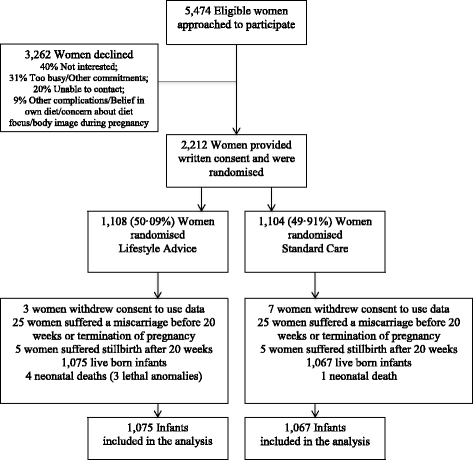The effects of antenatal dietary and lifestyle advice for women who are overweight or obese on neonatal health outcomes: the LIMIT randomised trial
- PMID: 25315325
- PMCID: PMC4194368
- DOI: 10.1186/s12916-014-0163-9
The effects of antenatal dietary and lifestyle advice for women who are overweight or obese on neonatal health outcomes: the LIMIT randomised trial
Abstract
Background: Overweight and obesity during pregnancy represents a considerable health burden. While research has focused on interventions to limit gestational weight gain, there is little information describing their impact on neonatal health. Our aim was to investigate the effect on a range of pre-specified secondary neonatal outcomes of providing antenatal dietary and lifestyle advice to women who are overweight or obese.
Methods: We report a range of pre-specified secondary neonatal outcomes from a large randomised trial in which antenatal dietary and lifestyle advice was provided to women who were overweight or obese. Pregnant women were eligible for participation with a body mass index of 25 kg/m(2) or over, and singleton gestation between 10(+0) and 20(+0) weeks. Outcome measures included gestational age at birth; Apgar score below 7 at 5 minutes of age; need for resuscitation at birth; birth weight above 4.5 kg or below 2.5 kg; birth weight, length and head circumference (and Z-scores); admission to the nursery; respiratory distress syndrome; and postnatal length of stay. Data relating to the primary outcome (large for gestational age infants defined as birth weight above the 90th centile) and birth weight above 4 kg have been reported previously. Analyses used intention-to-treat principles.
Results: In total, 2,142 infants were included in the analyses. Infants born to women following lifestyle advice were significantly less likely to have birth weight above 4.5 kg (2.15% versus 3.69%; adjusted risk ratio (aRR)=0.59; 95% confidence interval (CI) 0.36 to 0.98; P=0.04), or respiratory distress syndrome (1.22% versus 2.57%; aRR=0.47; 95% CI 0.24 to 0.90; P=0.02), particularly moderate or severe disease, and had a shorter length of postnatal hospital stay (3.94±7.26 days versus 4.41±9.87 days; adjusted ratio of means 0.89; 95% CI 0.82 to 0.97; P=0.006) compared with infants born to women who received Standard Care.
Conclusions: For women who are overweight or obese, antenatal dietary and lifestyle advice has health benefits for infants, without an increase in the risk of harm. Continued follow-up into childhood will be important to assess the longer-term effects of a reduction in high infant birth weight on risk of child obesity. Please see related articles: http://www.biomedcentral.com/1741-7015/12/161 and http://www.biomedcentral.com/1741-7015/12/201 .
Clinical trial registration: Australian and New Zealand Clinical Trials Registry ( ACTRN12607000161426 ).
Figures
Comment in
-
Obesity in pregnancy: could lifestyle interventions work?BMC Med. 2014 Oct 13;12:201. doi: 10.1186/s12916-014-0201-7. BMC Med. 2014. PMID: 25318013 Free PMC article.
References
-
- 2007 Australian National Children’s Nutrition and Physical Activity Survey. Edited by Australian Government Department of Health and Ageing. Canberra: 008. Publications Number: P3 – 4592, Online ISBN: 1-74186-757-6.
-
- World Health Organisation: Global Strategy on Diet, Physical Activity and Health: Childhood Overweight and Obesity. Geneva: 2011. http://www.who.int/dietphysicalactivity/childhood/en/.
Publication types
MeSH terms
Associated data
Grants and funding
LinkOut - more resources
Full Text Sources
Other Literature Sources
Medical


